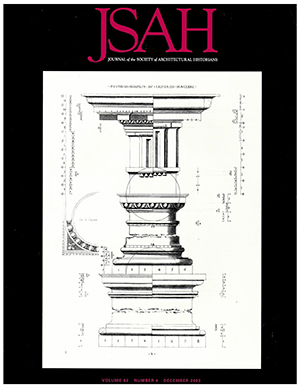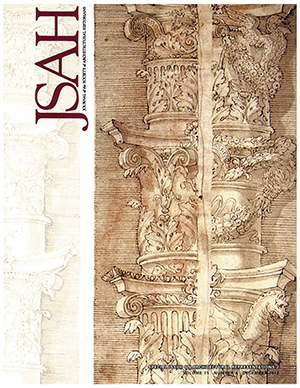-
Membership
Membership
Anyone with an interest in the history of the built environment is welcome to join the Society of Architectural Historians -
Conferences
Conferences
SAH Annual International Conferences bring members together for scholarly exchange and networking -
Publications
Publications
Through print and digital publications, SAH documents the history of the built environment and disseminates scholarship -
Programs
Programs
SAH promotes meaningful engagement with the history of the built environment through its programsMember Programs
-
Jobs & Opportunities
Jobs & Opportunities
SAH provides resources, fellowships, and grants to help further your career and professional life -
Support
Support
We invite you to support the educational mission of SAH by making a gift, becoming a member, or volunteering -
About
About
SAH promotes the study, interpretation, and conservation of the built environment worldwide for the benefit of all
Constructing Orders: From the Vault
From the Vault is a series of postings on the intellectual impact that the Society’s journal has made on how we think about the architectural discourse of the past. It is an opportunity to reflect on the essays that have made personal impact on the readers or simply stand out vividly in the rolling sequence of memory.


From the Vault is a series of postings on the intellectual impact that the Society’s journal has made on how we think about the architectural discourse of the past. It is an opportunity to reflect on the essays that have made personal impact on the readers or simply stand out vividly in the rolling sequence of memory. If you are interested in posting a similar reflection, please email it to kkourelis@gmail.com.
I will begin the series by reflecting on two covers from JSAH 62:4 (2003) and JSAH 71:4 (2012), the former orderly, mechanical and measured, the latter sketchy, informal, and layered. Spaced by nine years, the covers testify to the ceaseless relevance of Renaissance historiography with the probing of different modalities explored by Mario Carpo’s “Drawing with Numbers: Geometry and Numeracy in Early Modern Architectural Design” (2003) and Michael J. Waters’ “A Renaissance without Order: Ornament, Single-sheet Engravings, and the Mutability of Architectural Prints” (2012). If Carpo makes the Renaissance relevant to AutoCAD, Waters makes it relevant to cutting-and-pasting.
Central to both essays is the question of practically reproducing the classical orders. Alberti’s uncoupling of design and building, gave the architectural drawing an autonomy that it never possessed (not even in antiquity). With a series of studies from the 1930s, revised in 1962, Rudolf Wittkower established the canonical reading of Renaissance architecture that we still hold dearly. The Architectural Principles in the Age of Humanism offered the precise dose of idealism for the age of barbarity, as experienced by World War II and the Holocaust. But the dominance of modernism after the War, ushered in a new kind of utopian or progressive humanism with little patience for classical imitation. Le Corbusier had so successfully encrypted his humanism, that it took a whole generation to discover it, think Colin Rowe’s “The Mathematics of the Ideal Villa.” Between 1930 and 1980, the Renaissance seemed utterly irrelevant. When revived in the 1980s, theatrically by Charles Moore, religiously by Alan Greenberg, and ironically by Robert Venturi, the Renaissance had become a polemical caricature.
At least, that is how we taught the story of the Renaissance, a fascinating chapter in the canon of western architecture, relevant when the west was in crisis, abandoned by modernism, and superficially revived by postmodernism. Coherent as this story may have been, it was growing a little dull. I confess, I had personally checked out on the Renaissance in the 1990s. And suddenly, in the Winter of 2003, my issue of JSAH arrived and brought with it a jolt. Mario Carpo took a simple problem. How did Alberti construct the shape of the Doric base? We all knew the answer: by following Vitruvius’s geometrical construction carried out visually on paper. Fast forward to the mid-16th century. How did Vignola construct a similar base? Carpo here shows the proportional measurements printed as numbers on the illustrations. By the 17th century, number-based proportions dominated shape-based proportion, and modern numbers had won the battle over ancient geometry. Although seemingly minor to the big questions of architectural theory (form, function, materials, labor), Carpo’s analysis of growing numeracy offered an architectural window into the mercantile revolution of capitalism and the growing mitigation of print. Carpo’s essay brought architectural history in closer alignment with pioneering art historians like Svetlana Alpers (on 17th-century Dutch art). More importantly, Carpo concludes his essay with a “Morality” challenge. Isn’t the quantification of design similar to our current digital revolution? “The change that is being brought about by computer-based design processes is so drastic that it compares with the consequences of the first rise of architectural numeracy five centuries ago.” What happened between the 15th and 17th centuries becomes hugely relevant to the realities of architectural practice today. The implication is that we cannot successfully tackle our own digitization without understanding its internal history.
Carpo’s essay had made me so happy. I assign it to many classes and pose the digital challenge to my students. No student leaves my class without learning the Vitruvian/Albertian construction of the Doric base and its afterlife. But in the last issue of JSAH came another jolt. Michael Waters has thrown a wrench in Carpo’s notions “that mechanical reproduction created stable, authoritatively identical reproductions that removed the creative drift inherent in the system of drawn copies.” Waters’ wrench comes from a series of unpublished 16th-century engravings from Ferrara. The drawings show what we might today call collage and appropriation, a dismembering of stable printed images into creative configurations. Print culture, Waters argues offered both stability and instability. The obvious stability that Carpo has so well examined was destabilized by processes of appropriation familiar to us in modernist collage and postmodernist digital manipulation. Through cutting, copying and pasting architectural prints, the early modern architect became a collage artist, an early bricoleur, a deconstructivist.
Between these two JSAH essays, we have a conversation and a universe of possibilities. Although seemingly antithetical, they reveals two sides of the same coin, as one needs stability in order to destabilize. But most importantly, this double-sided coin has an incredible currency in the concerns of the present. The Renaissance is not a simple style that generations reject (modernism) or endorse (postmodernism), but a problematic. Both Carpo and Waters unleash the powers of the case-study. The present becomes incomprehensible without the aid of the case-studies from the past. The Renaissance is simply unavoidable. We cannot briskly teach over it as a nice period or consume it for its obvious beauty. My own personal interests in the Renaissance are marginal at best. Yet what I do as a scholar on a daily basis depends entirely on Wittkower, or Manfredo Tafuri, or Dalibor Vesely, for whom the Renaissance is an early chapter of the book we are living at this very present. Carpo’s JSAH essay has been indispensable to my teaching, and I am thrilled to supplement it with Waters’ contrasting voice.



Leave a commentOrder by
Newest on top Oldest on top